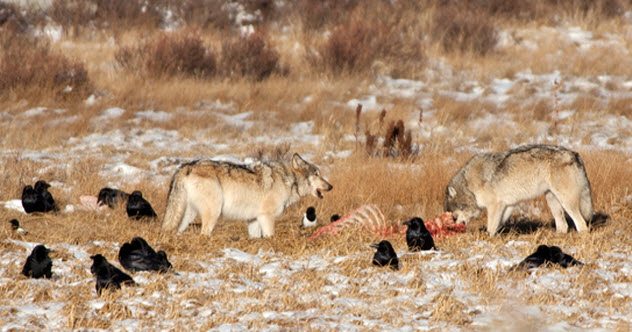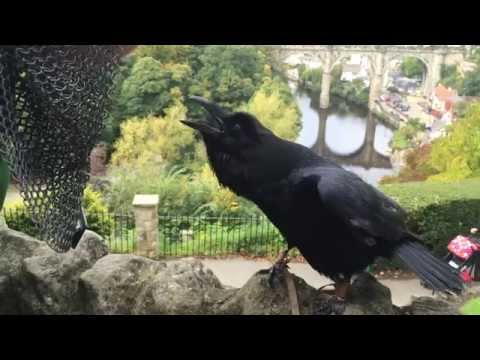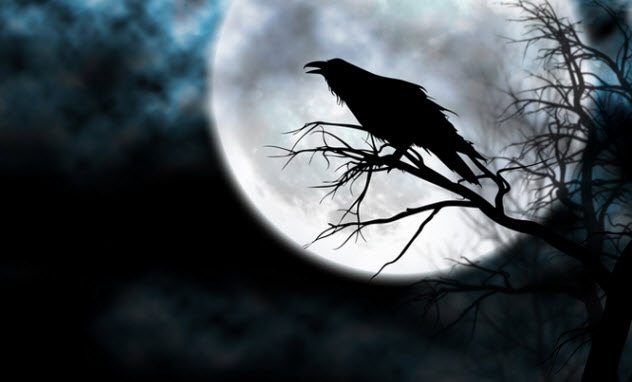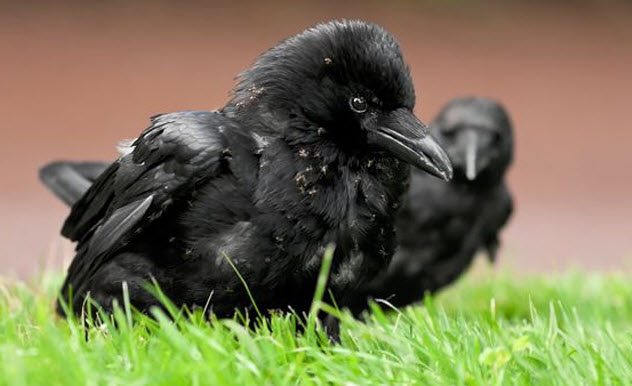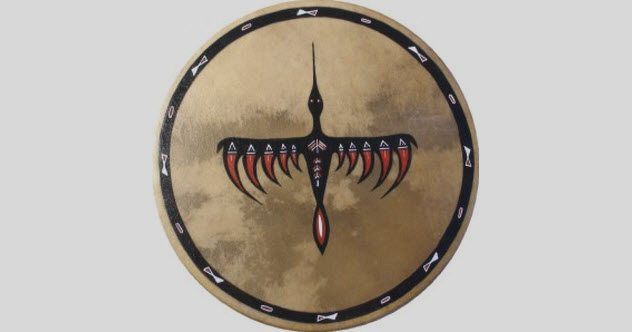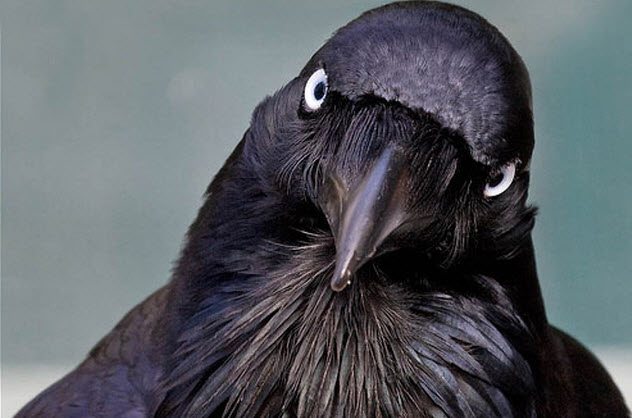In the smoldering remains of wrathful destruction, nothing was permitted to pass through except ravens. It was totally cool if they lived there. As you can imagine, this didn’t do much to bolster their image. Beyond acting as harbingers of death and adorning spooky Halloweenscapes, ravens are actually highly intelligent, adaptable, and truly fascinating creatures. SEE ALSO: 10 Shockingly Creepy and Bloodthirsty Birds
10 They Are Crazy Smart
People have always known that ravens are smart. That’s nothing new. But we are just beginning to discover exactly how smart these common scavengers really are. Ravens are now said to have “humanlike” intelligence, which is actually a big deal. The Corvidae family, of which ravens are a part, includes crows, magpies, jays, and jackdaws. This entire family of birds holds the prestigious title of being considered among the smartest birds in the world. A 2002 study in Science showed that a New Caledonian crow could bend a piece of wire into the shape of a hook so that it could retrieve food from a narrow space. Young children were presented the same puzzle and were unable to match the mental dexterity of our feathered friends. A study conducted by researchers in the biology department of a Moscow university proved that crows are capable of analogical reasoning after testing the birds with a series of flash cards in a matching game. When correct matches were made, the crows were rewarded with mealworms. Matching things is considered to be a higher-order reasoning process, and these birds already possessed the capacity without extensive training.[1] Ravens have been seen sliding on snow with makeshift sleds made of bark and examining human-made objects that they find. They’re creative and adaptable, and they’re disproving one hater at a time that “birdbrained” is not really an insult.
9 They Have A Special Friendship With Wolves
There’s no doubt that wolves possess the strength and savvy to hunt by themselves, but it is not the most efficient method for them thanks to their feathered friends. During a recent study, it was observed that within a minute of wolves dropping a moose, ravens were already on it. It is estimated that a pair of wolves will lose almost 40 percent of that moose to ravens. With six wolves, on the other hand, ravens are only able to make off with about 17 percent of it. Though ravens and wolves may seem like unlikely bedfellows, it is a mutually beneficial relationship even if it looks like wolves are getting the short end of the straw here. For ravens, it makes sense to follow wolves around and scavenge the remains of their kills. One raven can scavenge 1.8 kilograms (4 lb) in a day from a 450-kilogram (1,000 lb) moose. Now imagine what several ravens could do. Scientists believe that this is exactly why wolves hunt in packs.[2] To pull their weight in this friendship, ravens lead wolves to animal carcasses that the ravens can’t eat because their beaks aren’t strong enough to break through the bodies of the dead animals. When wolves are preoccupied with their kill, ravens also alert them to suspicious sounds and potential danger.
8 They Can Talk
Though ravens may seem like they’re making a series of random “kraas,” their varied sounds are believed to contain meaning. In the wild, ravens communicate with each other through a wide range of vocalizations. They can express emotions such as tenderness, happiness, anger, and surprise. They can also alert each other to danger by clucking like hens and make trill sounds when ready for battle. They have a specific “haaa” sound that they use for meat.[3] Within their own social groups, they have been shown to have their own dialects. In captivity, ravens can learn to talk better than a lot of parrots can. Human speech isn’t the only things these guys can imitate. Ravens can also replicate wolves (which comes in handy when trying to lure them to carcasses that the ravens can’t cut open on their own), other birds, garbage trucks, and toilet flushing.
7 They Are Often Seen As Omens
Maybe it is the darker-than-night plumage or their habit of hovering over corpses. Whatever the reason, ravens have played a key role in mythology and superstition since ancient times. In Celtic mythology, ravens were said to be an omen of battle and bloodshed. The Irish believed that the war goddess would call ravens down from the sky to eat the corpses of the fallen. This actually made sense because this is exactly what ravens do, goddess or no goddess. The Hindus see ravens as the souls of the deceased which represent bad or good luck. In Germany, ravens are believed to hold the souls of the damned. Arabs call the raven “Abu Zajir” (“Father of Omens”).[4] Swedish folklore tells us that ravens are the ghosts of those who were murdered and did not receive proper burials.
6 They Enjoy Getting Stoned
Obviously, this does not mean kicking back with some reefer and a 40—that just is not their style. What they do enjoy is really freaking weird: They partake in something called anting. This involves smashing ants and rubbing them all over the ravens’ bodies. Ants produce formic acid when smashed, which is absorbed into the ravens’ skin and apparently feels incredibly good to them. Why do they do this? No one knows for certain, but there is no shortage of theories. One idea suggested that anting was a form of prey preparation that makes ravens immune to the formic acid. That way, ravens can eat ants without any ill effects. Some believe that anting is a learned behavior. Others think it’s instinct and the birds just can’t help themselves. Maybe the formic acid acts as a sort of weird bath oil and has a soothing effect on the skin.[5] Birds who engage in anting appear to be in total bliss and high as a kite. Maybe it really is that simple. We humans do have a tendency to overthink things. Perhaps the real reason that ravens and other birds (such as the crow pictured above) cover themselves in squashed ants is that it just feels good.
5 They’re Empathetic
Though a group of ravens is called an “unkindness,” ravens are actually highly empathic. A study published in PLOS One in 2010 found that ravens console the victim of an act of aggression. For two years, Orlaith Fraser and Thomas Bugnyar observed the behavior of 13 hand-reared ravens. During that time, they observed 152 fights. They categorized the ravens as aggressors, victims, and bystanders depending upon their role in the altercation. Ravens that spent the most time with the victims showed the greatest likelihood of engaging in consoling behavior, which includes beak-to-body touching, sitting close to the victim, and preening. Though not as likely to engage, bystanders at least took notice that the victim was in distress. Previously, we hadn’t given ravens credit for the higher thought processes associated with empathy. To display empathy, they must be able to comprehend the situation and then adjust their behavior toward the victim accordingly.[6]
4 They’re Secretly Pirates
Maybe they aren’t out pillaging and plundering across the seven seas, but they have a couple of skills that are important for any proper pirate. One of those skills is bargaining and the ability to think ahead. An experiment conducted by Can Kabadayi and Mathias Osvath at Lund University in Sweden proved that ravens possess the cognitive ability to preplan and bargain for what they want. Kabadayi and Osvath trained a group of ravens to use a specific tool on a box to retrieve a treat. Then the researchers took the box away and came back an hour later with a selection of objects for the ravens to choose. One of those objects was the tool needed to open the box. Eighty percent of the time, the ravens selected the tool and were able to perform the task to retrieve the treat when the box was returned to them 15 minutes later. The experiment was conducted again with a 17-hour delay, and 90 percent of the time the ravens got it right. The birds also used tokens to barter for food. Another ability possessed by ravens that make them a much better choice than parrots to sit on a pirate’s shoulder is their intolerance for cheaters. Researchers at Lund University in Sweden conducted an experiment that involved trading with ravens and then cheating them to see if they’d remember. They remembered. In the first phase, one researcher handed the raven a piece of bread that he could take to the second researcher for a more appealing piece of cheese. In the next phase, the raven would bring the bread to the second researcher for exchange. Rather than hand over the cheese, the researcher popped the yummy morsel of cheese into his mouth. After a couple of days, the experiment was conducted again with a neutral third researcher. The ravens hadn’t worked with this person earlier. Six of the seven birds chose to trade with the researcher they considered “fair” (the one who didn’t eat the cheese), and one of the ravens chose the “neutral” researcher. A month later, only one chose the “unfair” researcher while the rest still wouldn’t trust him.[7] If ravens could force someone to walk the plank, the “unfair” researcher would be the first into the drink.
3 Ravens Protect The Tower Of London
Although no one knows how the rumor started, it is said that the presence of ravens in the Tower of London ward off bad fortune. Should the ravens ever leave, the tower and the monarchy would fall. One theory gives credit to author Geoffrey of Monmouth who wrote about King Bran Hen of Bryneich. Bran, which means “raven” in Welsh, requested that his head be buried at the tower to act as a talisman against invasion. Ravens have been there ever since. In 1661, Charles II ordered that six ravens must be kept at the tower constantly. They are still there.[8]
2 They Are Tricksters
The cunningness of ravens has long been incorporated into mythology and lore. Many Native American tribes believed the raven to be a trickster and even a shape-shifter. The raven’s non-secretive ways made it easy for the casual observer. The Sioux told of a white raven that would warn buffalo of nearby hunting parties, which would cause the buffalo to stampede. According to the legend, an angry shaman got fed up with the raven and tossed him into the fire, which caused his feathers to turn black.[9] Since scientists have been paying more attention to ravens, they have noticed some rather trickster-like behavior. A study by the University of Vermont showed that juvenile ravens will make a big fuss when feeding on a carcass to attract other juvenile ravens to join them. This helps to ensure their safety against adult crows and other scavengers. Ravens have also been observed pretending to hide food in one place before quietly hiding it in another to throw off other ravens.
1 They Recognize And Remember Your Face
Next time you contemplate chasing ravens from your yard, you may want to stop and rethink your strategy. Ravens, crows, and other corvids are not keen on forgiving or forgetting. Wildlife biologist John M. Marzluff put this idea to the test at the University of Washington campus in Seattle. Seven crows were tagged and released on the campus by researchers wearing masks. Dangerous (scary) and neutral masks were worn around campus to provoke a reaction from the birds. Sure enough, people wearing the “dangerous” masks were scolded by the crows by swooping and dive-bombing the masks. Keep in mind that the researchers weren’t messing with the birds at this point, just walking from one point on campus to another. Those birds were not having it with the scary masks, although the people who wore neutral masks were left alone. Over time, crows told their friends, who then told their friends. At one point while Dr. Marzluff was taking a stroll in his “dangerous” mask, 47 of the 53 crows he encountered were ready to throw down. Aesop had it all wrong. In his fable “The Fox and the Crow,” the unsuspecting corvid plays right into the fox’s silly game by dropping his food so the fox can take it. The fox leaves after some snide parting remarks about the crow’s intelligence.[10] Had this been real life, the fox would not have made off with the meal. Meanwhile, the bird surely would have held a grudge, dive-bombed the fox, and stolen his next meal with the aid of his equally angry crow gang. Melynda Sorrels is a writer, student, reckless blogger, dreamer, and an aficionado of all things funny or caffeinated.

